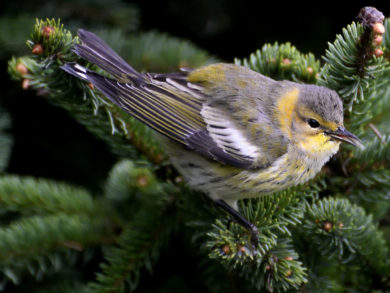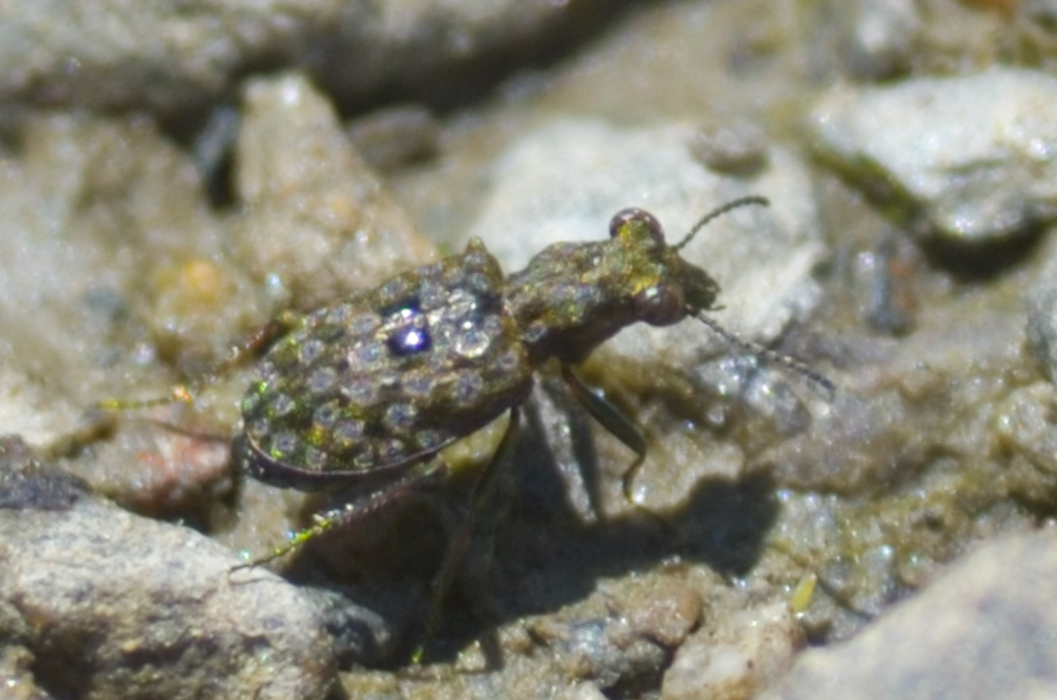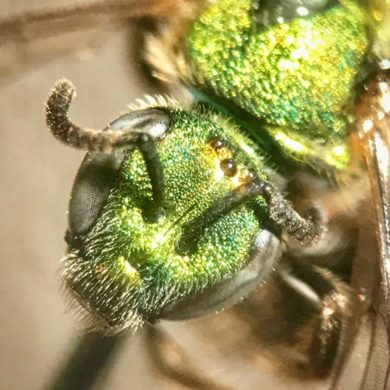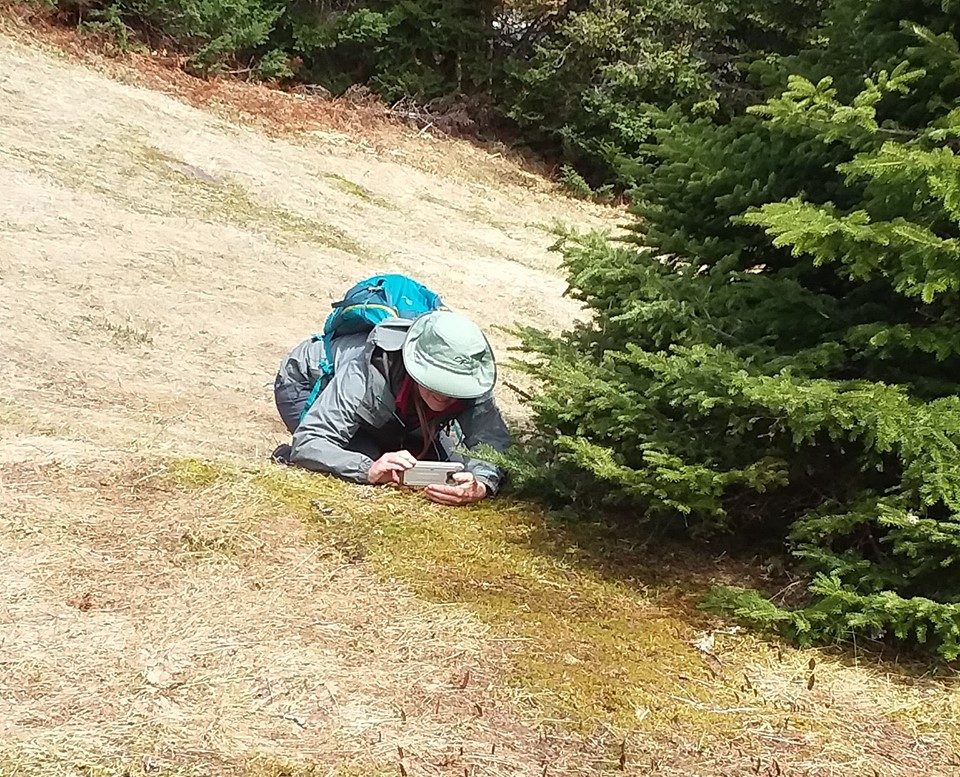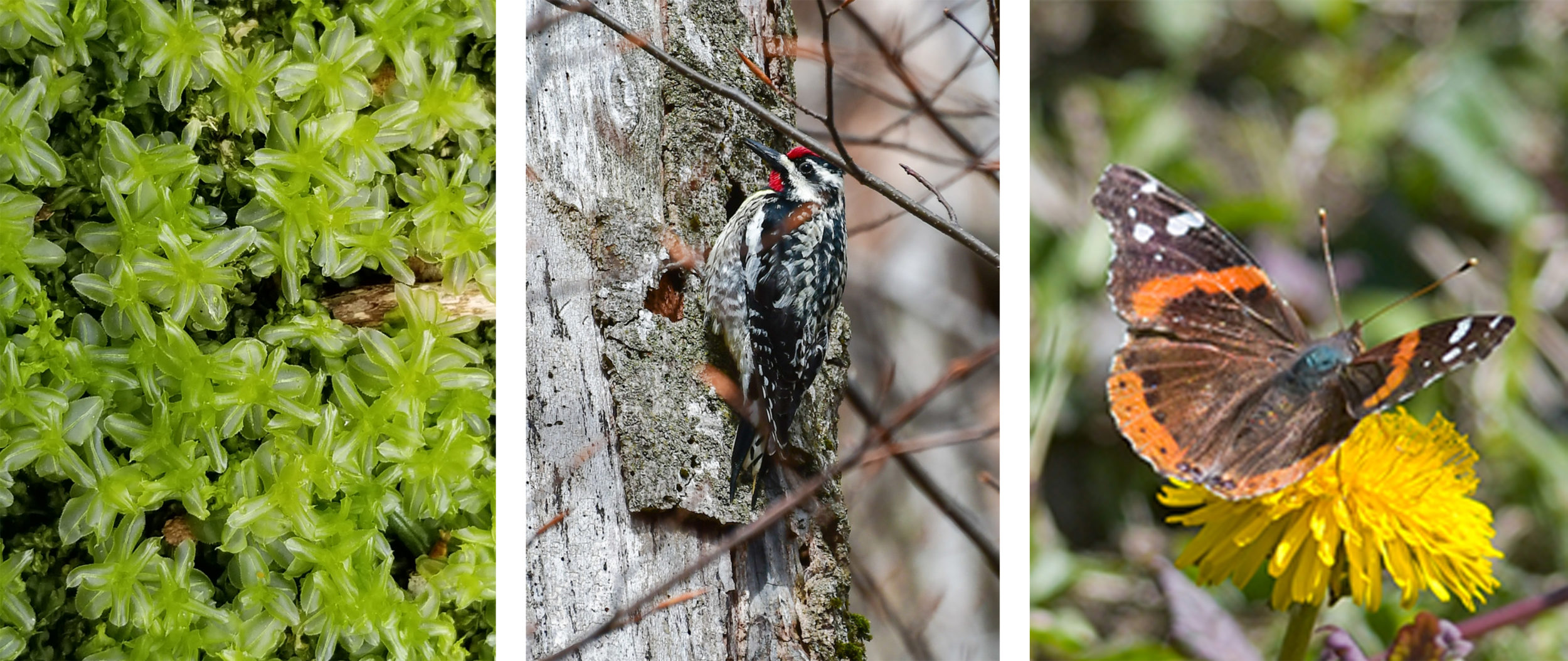
Wavy-leaf Moss / © Micki Colbeck; Yellow-bellied Sapsucker / © Marc Faucher; Red Admiral / © Nathaniel Sharp
Seven intrepid VCE Biothon teams, comprised of staff and volunteer citizen scientists (some seasoned, some new), ventured out on May 18 for a one-day blitz to document Vermont’s biodiversity in support of VCE’s wildlife conservation programs. With spirits bolstered by generous pledges from people like you and a matching grant from The Jack & Dorothy Byrne Foundation, our teams’ efforts yielded an impressive 117 bird species and 217 species of plants, non-avian animals, fungi, and other life forms. These observations have been cataloged in the Vermont Atlas of Life on iNaturalist and shared with an international data warehouse—the Global Biodiversity Information Facility—aimed at providing anyone, anywhere, open access to data about all types of life on Earth. A more local, yet equally important, outcome from the day is that VCE biologists and local volunteers were able to work side-by-side, learning more about the natural world, meeting fellow naturalists, strengthening Vermont’s conservation community, and spending time outdoors.
In this report you’ll find individual team summaries, and if you’d like to see the master tallies of birds and all other species found on Biothon day, click here. If you have any questions or would like detailed information about where certain species were found, please don’t hesitate to contact us. Thanks sincerely from all of us for helping make Biothon 2019 an unqualified success! We’re already looking forward to next year’s quests, and hope you’ll join us then.
Norwich Nighthawks (Norwich)
Team leader: Chris Rimmer
In 45 years of birding, I’ve never experienced anything like the spectacle of Cape May Warblers that enthralled our team on Biothon day (we had >15 in one tree!). Our team focused on birds, beating the proverbial bushes from dawn until dusk. We found 97 species, all but one (a Swainson’s Thrush just over the Thetford line) in Norwich. Eighteen warblers also included Tennessee, Magnolia, Canada, and Wilson’s. An Eastern Meadowlark at Pirouette Farm on Hogback Road was unexpected, as was a pair of Northern Mockingbirds there. With water levels on the Connecticut River high, shorebirds were scarce, though four Short-billed Dowitchers roosting in shoreline vegetation below the Ledyard Bridge were a real surprise. A great day to be out!
Windham Wings (Windham County)
Team leader: Nathaniel Sharp
My morning started at 5:00 a.m. with strong coffee, an American Bittern, and singing Swainson’s Thrush at Upper Meadows Road. Birding Herrick’s Cove was next on the agenda—highlights there included good looks at Canada Warbler, Brown Thrasher, and Blue-gray Gnatcatcher. The Cove didn’t disappoint, with 50 bird species tallied in short order! Onward to Allen Brothers Marsh, where Great Blue Heron, Eastern Bluebird, and Yellow Warblers stole the show, as well as a nice assortment of bees, hoverflies, and damselflies. My last stop of the day was the Putney Great Meadow, which turned out to be a fantastic spot for insects—notably sweat bees, small carpenter bees, bumblebees, and an interesting and strikingly patterned beetle of the genus Elaphrus (see photo). This captivating day in the field yielded 77 bird species and 15 other flying critters.
Enumerating Eukaryotes (Rupert)
Team leaders: Jason Hill, Tim Duclos
We had a rousing good day at Merck Forest & Farmland Center—a small group of fun and passionate naturephiles romping across the landscape in a collaborative quest to explore the wild life around us. Highlights included watching birds up close at eye level in an early successional patch cut lit with magical morning sunlight; marveling at an active raven nest in a barn; observing mason bees gathering mud for nest closures; honing our senses to the world around us, trying not to miss a single species; and tacos, beer, and an hour of conversations about life afterwards. By the end of the day, our team tallied 59 bird species and 80 species from 16 other classes(!) of life. We learned and laughed a lot, all the while contributing our data to the greater good. It was tough to go back to the office afterward!
Crepuscular Cuckoos (Missisquoi NWR)
Team leader: Sarah Carline
It was World Migratory Bird Day at the refuge, and we kicked off the celebration at 4:45 am on a cool, cloudy, windy morning with a Wilson’s Snipe, Virginia Rail, a calling Pied-bill Grebe, and a herd of more than 20 deer. After our morning walk, we met a large group of 25+ birders at park headquarters and split up into several teams to count birds for the day. Highlights included an American Bittern, Canada Goose goslings, Orchard Orioles, and Osprey on a nest. A trip to nearby Highgate Airfield yielded Grasshopper Sparrows, Eastern Towhees, and Vesper Sparrows. We watched a woodcock peenting, heard calling Whip-poor-wills and a Barred Owl to check off our “crepuscular” list, and then heard a Sora at a nearby swamp to end the night! All in all, we tallied 100 bird species and 22 non-bird species. It was a long but very rewarding day, as we shared knowledge with new birders at the refuge, strengthened connections with VCE constituents, and made plenty of new friends!
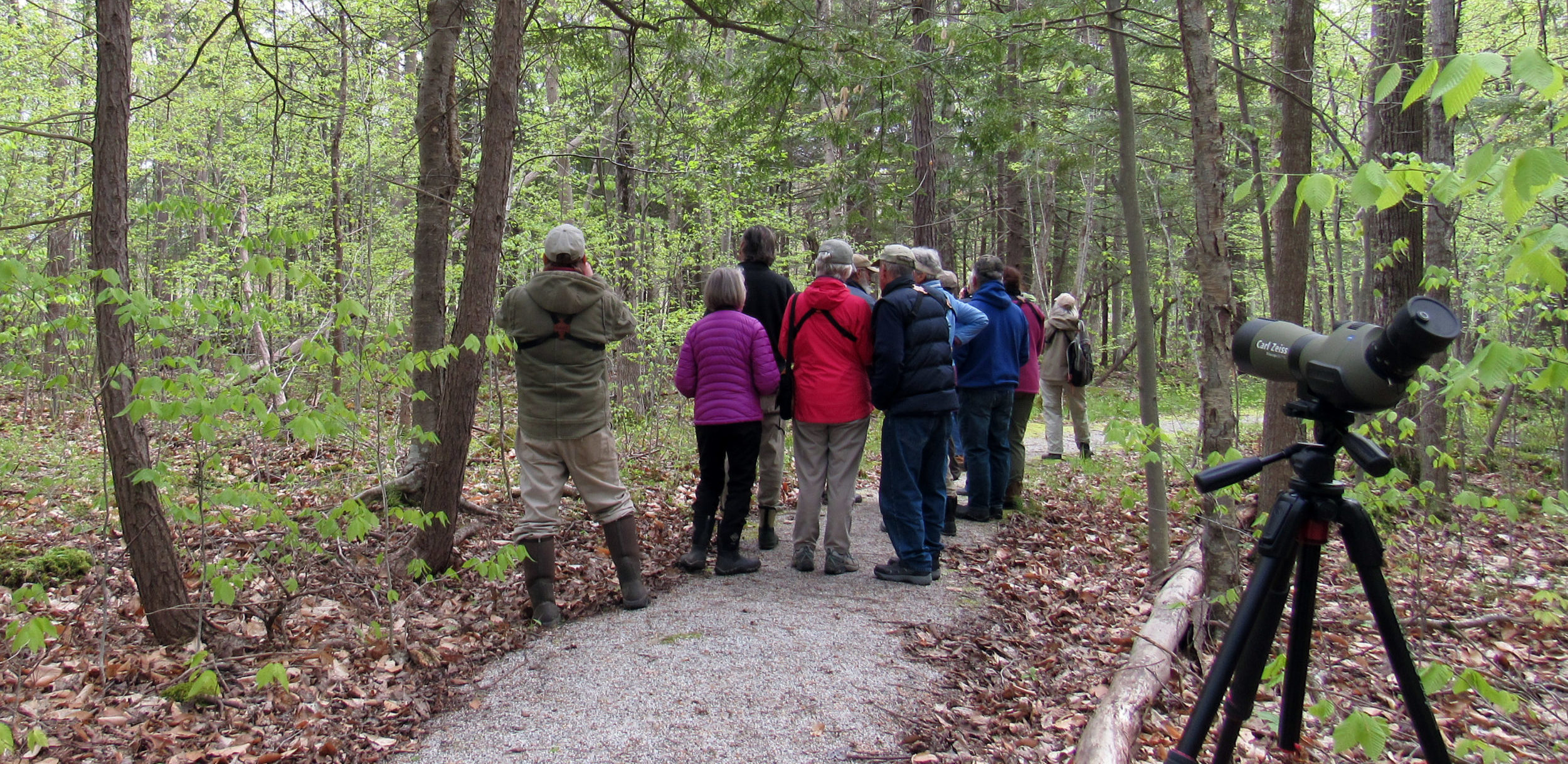
The Crepuscular Cuckoos consult a field guide for help identifying an Orchard Oriole in Missisquoi National Wildlife Refuge./ © Sarah Carline
The Bee Team (Chittenden County)
Team leaders: Kent McFarland, Spencer Hardy
Donned with billowing nets and colorful bee bowls, the Bee Team scoured brushland, grassland, and backyards for VCE’s new VTBees wild bee survey project. With over 300 wild bee species known to roam Vermont, we had high hopes. Despite intermittent cloudy conditions, we found about 26 bee species. Bees are difficult to identify to species, and many of them require close looks under a microscope. After our field work was finished, we spent several hours preparing and sorting the ~140 specimens we collected for definitive identification later this year. And in case you’re wondering… nobody got stung. Most wild bees are so small you wouldn’t feel their wrath even if they did get mad. In true Biothon spirit, we birded a bit while searching for bees, recording a list of 30 species, kept our eyes alert for butterflies (recording just three species), and of course added other interesting biodiversity that caught our eyes to the Vermont Atlas of Life on iNaturalist. It was an enjoyable and rewarding day in the field and lab for all involved!
The Loonies (Northeast Kingdom)
Team Leader: Eric Hanson
The Loonies combined counting birds and Vermont Loon Conservation Project work on Biothon day. Our morning began with birding wetlands along the Black River on the way to Zack Woods Pond in Hyde Park. There we watched a pair of courting Eastern Kingbirds and a continually singing Blue-head Vireo that seemed to follow us around the pond. We paddled out to place nest warning signs for the resident loon pair, and witnessed the eviction of an intruder loon—the resident male blasting its classic warning yodel, complemented by lots of bill dipping and charging the unwelcome guest. Eventually, the extra loon decided he (or she) had better leave. We tallied 41 bird species for the day, from Ruby-throated Hummingbirds and Ruby-crowned Kinglets to American Bitterns and Ruffed Grouse. Contributing eBird checklists and protecting nesting loons– all in a day’s work for Team Loony!
Stark Raving Mad Naturalists (Stark Mountain, Waitsfield)
Team Leaders: Roz Renfrew, Sean Lawson
Eight Mad Naturalists spent the day meandering up and down Stark Mountain in search of birds and other species. Sean Lawson was an excellent local guide, leading us down secret side trails to explore natural history phenomena—like an American Beech stand full of bear nests and claw markings, and “vernal puddles” chock-full of amphibian eggs. In more than six miles of hiking and 2000′ elevation gain we counted 25 species of birds—but notably, not a single thrush (Bicknell’s or otherwise). At these higher elevations, spring phenology was further behind, and a number of bird species hadn’t yet arrived. In the non-avian realm, two committed team members logged 120 observations of 76 other species to iNaturalist. After our hike we headed to Lawson’s Finest Liquids Taproom for a well-deserved round of frosty beverages. And as a last Biothon hurrah, we birded the boardwalk along the Taproom property, picking up another 10 species for our day’s tally. Everyone learned something new, got a solid workout, and had an excellent time!
